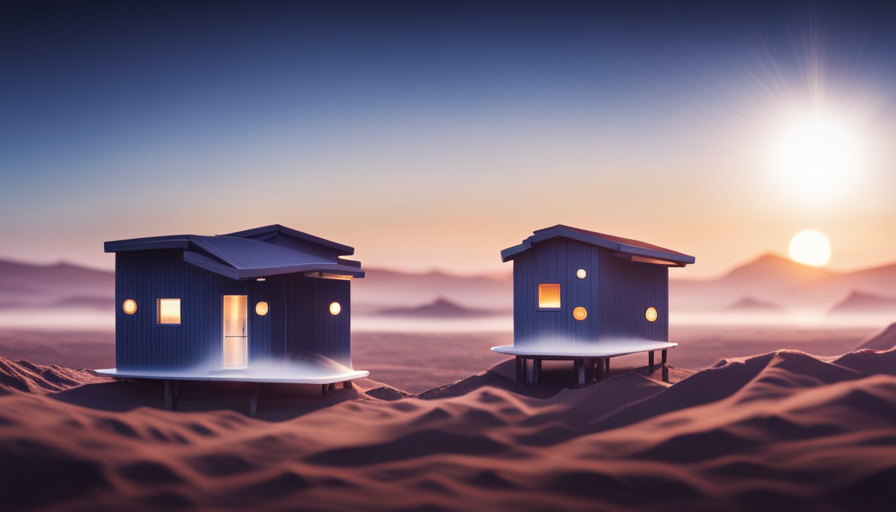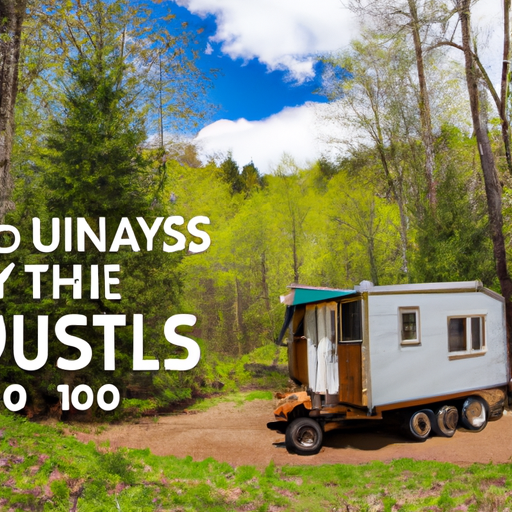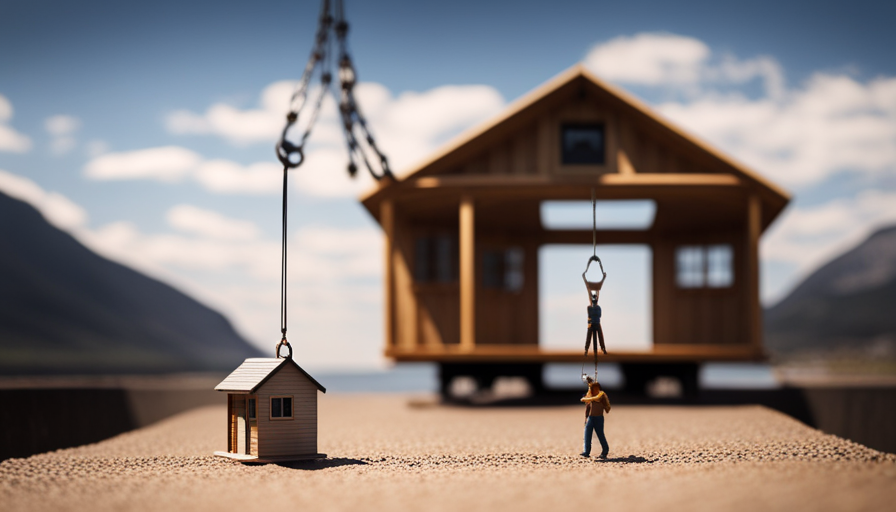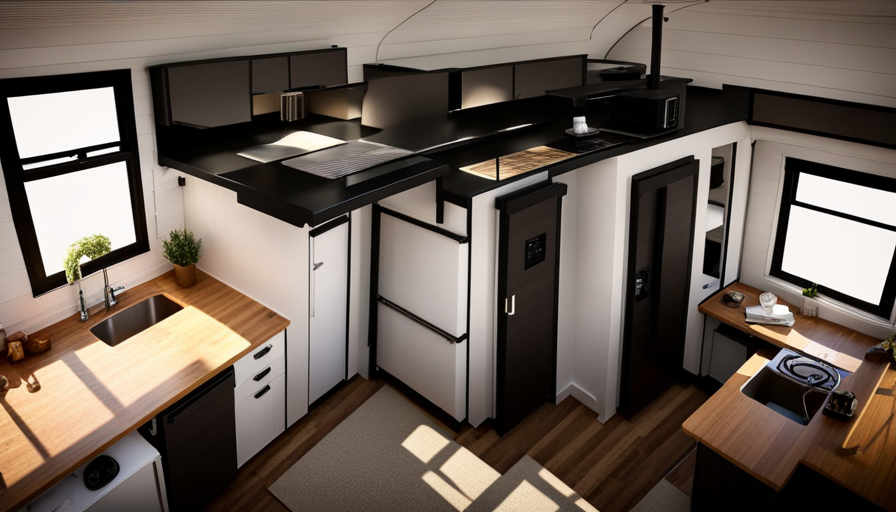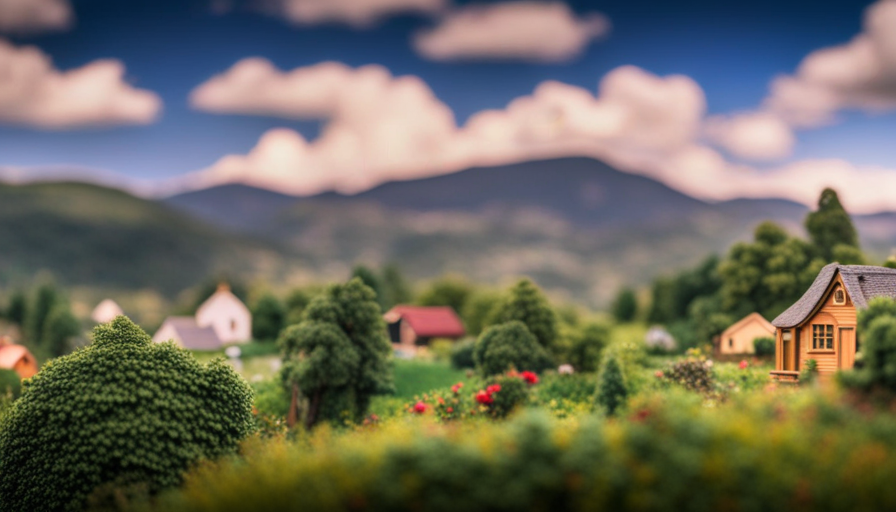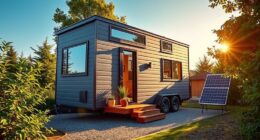What is the necessary size of a solar system for a small house?
It’s a burning question for those of us seeking an economical and eco-friendly way to power our humble abodes.
In this informative and practical article, I will guide you through the process of assessing your energy needs, calculating your daily energy consumption, and choosing the right solar panel wattage and battery capacity.
We will also consider factors such as location, climate, charge controllers, backup power options, and future expansion.
Seeking professional advice and installation is crucial to ensure optimal performance and efficiency.
So, if you’re ready to embark on a journey towards energy independence, join me as we unravel the secrets of sizing the perfect solar system for your tiny house.
Let’s shed some light on this electrifying topic!
Key Takeaways
- Accurately assess energy needs and optimize energy efficiency to determine the size of the solar system required for a tiny house.
- Consider factors such as location, climate, charge controllers, backup power options, and future expansion when choosing the right solar system.
- Calculate daily energy consumption by listing appliances, power ratings, and daily usage hours to determine the solar panel wattage needed.
- Choose battery capacity based on energy needs, daily consumption, depth of discharge, and battery efficiency to ensure optimal performance in a tiny home.
Assess Your Energy Needs
To accurately assess your energy needs, you’ll need to determine the amount of electricity required to power your tiny house. This involves assessing your energy usage and optimizing energy efficiency.
The first step is to calculate your daily energy consumption. Start by making a list of all the appliances and electronics you plan to use in your tiny house. Consider their power ratings, which can usually be found on the label or in the user manual. Multiply the power rating by the number of hours you expect to use each device per day to calculate the energy consumption in watt-hours.
Add up the energy consumption of all your devices to get a total daily energy consumption. It’s important to be honest and realistic when estimating your energy needs.
Once you have an accurate assessment of your energy consumption, you can determine the size of the solar system you’ll need to meet your energy requirements. This will help you make an informed decision about the size and capacity of the solar panels, batteries, and other components you’ll need for your tiny house.
Calculate Your Daily Energy Consumption
Calculating your daily energy usage is like taking a snapshot of your power consumption habits. It allows you to understand how much energy you require on a daily basis and helps you determine the size of the solar system you need for your tiny house.
To calculate your daily energy consumption, you can follow these steps:
-
Identify your appliances: Make a list of all the appliances you use regularly in your tiny house, including lights, refrigerator, heating, cooling, and electronics.
-
Determine power ratings: Check the power ratings of each appliance, usually measured in watts, and note them down.
-
Estimate daily usage: Estimate the number of hours you use each appliance on a daily basis. This will give you an idea of how much energy each appliance consumes.
-
Calculate energy consumption: Multiply the power rating of each appliance by the number of hours you use it daily. Sum up the energy consumption of all appliances to get your total daily energy consumption.
By calculating your daily energy consumption, you can assess your energy needs accurately and explore alternative energy sources like solar power. This will help you determine the size of the solar system required for your tiny house. Considering your location and climate will be the next step in making an informed decision about your solar system setup.
Consider Your Location and Climate
When considering your location and climate, it’s important to factor in the specific conditions that will impact your energy needs.
Location specific challenges can play a significant role in determining the size of the solar system required for your tiny house. For example, if you live in an area with limited sunlight or frequent cloudy days, you may need a larger solar system to compensate for the reduced energy production.
Additionally, if your location experiences extreme temperatures, such as very hot summers or cold winters, your energy needs may be higher due to increased heating or cooling requirements.
Climate considerations are also crucial when determining the size of your solar system. If you live in a region with high humidity or heavy rainfall, you will need to ensure that your solar panels are properly installed and maintained to prevent any water damage. Similarly, if you reside in an area prone to strong winds or storms, you may need to invest in sturdier mounting systems to secure your solar panels.
Taking into account these location specific challenges and climate considerations will help you accurately assess your energy needs and determine the appropriate size of your solar system.
With this information, you can now move on to the next section and determine the wattage of solar panels required for your tiny house.
Determine Your Solar Panel Wattage
Consider the unique energy requirements of your location and climate to accurately determine the wattage of solar panels needed for optimal power generation in your tiny house. One of the crucial factors to consider is solar panel efficiency. This refers to how well the panels convert sunlight into electricity. Higher efficiency panels will generate more power, allowing you to meet your energy needs with fewer panels. While these panels tend to be more expensive, they can be a worthwhile investment in the long run.
Another important consideration is your budget. Solar panels come in various wattage options, and the larger the wattage, the more power it can generate. However, higher wattage panels also tend to be more expensive. It’s essential to strike the right balance between power generation and cost. Assess your energy needs and budget to determine the optimal wattage for your tiny house.
In addition to these considerations, you should also take into account the climate of your location. If you live in an area with ample sunshine throughout the year, you may require fewer panels compared to a region with less sunlight. It’s crucial to factor in the average daily sunlight hours and the intensity of sunlight in your location to accurately calculate the wattage needed.
With these factors in mind, you can determine the appropriate wattage of solar panels for your tiny house. Once you have determined the wattage, you can move on to choosing the right battery capacity for storing the generated power.
Choose the Right Battery Capacity
When determining the right battery capacity for my solar system, I need to calculate the required capacity based on my energy needs. This involves considering the amount of energy I’ll be consuming on a daily basis and ensuring that my battery can store enough power to meet those needs.
Additionally, I need to take into account the depth of discharge and battery efficiency. It’s important to understand how much of the battery’s capacity can be used before it needs to be recharged, as well as how efficiently the battery can store and release energy.
By considering these factors, I can choose the right battery capacity for my solar system.
Calculate the required battery capacity based on your energy needs
To calculate the required battery capacity for your energy needs in your tiny house, you’ll want to crunch the numbers and figure out how much power you’ll be using on a daily basis. This will help you determine the appropriate battery size for your system.
When considering battery types and energy storage options, keep in mind the following:
-
Energy Consumption: Make a list of all the electrical appliances and devices you plan to use in your tiny house. Determine their power consumption in watts and how long you’ll use them each day.
-
Daily Energy Usage: Multiply the power consumption of each device by the number of hours you’ll use it daily. Sum up these values to find your total daily energy usage.
-
Battery Capacity Calculation: Divide your total daily energy usage by the depth of discharge and the battery efficiency to calculate the required battery capacity.
Considering the depth of discharge and battery efficiency will help you optimize your battery system for your tiny house’s energy needs.
Now, let’s explore how to consider these factors in more detail.
Consider the depth of discharge and battery efficiency
Optimizing your battery system will ensure you have reliable power for your energy needs and give you peace of mind in your tiny home.
When considering the depth of discharge and battery efficiency, it’s important to understand how these factors can affect the overall performance of your solar system.
The depth of discharge refers to the amount of battery capacity that’s used before recharging. It’s recommended to keep the depth of discharge at around 50% to prolong the lifespan of your batteries.
Additionally, battery efficiency plays a crucial role in maximizing the energy output. Higher efficiency batteries will allow you to get more power out of the same amount of sunlight.
By considering both the depth of discharge and battery efficiency, you can ensure that your solar system operates at its optimal level.
Now, let’s move on to the next step and select an inverter.
Select an Inverter
In order to power a tiny house, selecting the right inverter is like choosing the heart of the solar system. The inverter converts direct current (DC) electricity produced by the solar panels into alternating current (AC) electricity that can be used to power household appliances. When selecting an inverter, it is important to understand its specifications to ensure compatibility with your solar system.
One key specification to consider is the inverter’s maximum power output, measured in watts. This determines the size and number of appliances you can run simultaneously. It is crucial to choose an inverter that can handle the peak power demands of your tiny house.
Another important specification is the inverter’s waveform. Modified sine wave inverters are more affordable but may not be suitable for sensitive electronics. Pure sine wave inverters, on the other hand, provide a cleaner and more stable power output, making them ideal for powering all types of appliances.
Efficiency is also a crucial factor. Look for inverters with high efficiency ratings as they convert more of the solar energy into usable electricity. This will help maximize the output of your solar system.
Incorporating a 3 column and 3 row table:
| Specification | Description | Importance |
|---|---|---|
| Maximum Power Output | Determines appliance capacity | High |
| Waveform | Modified or pure sine wave | Variable |
| Efficiency | Conversion of solar energy | High |
Selecting the right inverter is an essential step in building a solar system for a tiny house. Once you have chosen the appropriate inverter, the next consideration is including a charge controller to regulate the battery charging process.
Include a Charge Controller
Including a charge controller is a must-have for ensuring the efficient and hassle-free operation of your solar setup in your cozy home. A charge controller acts as the brain of your solar system, regulating the flow of electricity from the solar panels to the batteries. It prevents overcharging, which can damage the batteries, and also protects against reverse current flow during the night or on cloudy days.
One of the key benefits of a charge controller is that it extends the lifespan of your batteries. By preventing overcharging and deep discharging, it helps maintain the optimal charge level, maximizing the longevity of your batteries. Additionally, a charge controller helps improve the overall efficiency of your solar system by optimizing the charging process. It ensures that the batteries receive the right amount of charge, improving their performance and reducing energy loss.
When selecting a charge controller, it’s important to consider the size of your solar system and the power requirements of your tiny house. Charge controller sizing is crucial to ensure that it can handle the maximum current produced by your solar panels. A properly sized charge controller will efficiently regulate the flow of electricity, preventing any potential damage or performance issues.
Now, let’s factor in backup power options to ensure uninterrupted power supply in case of emergencies or low sunlight conditions.
Factor in Backup Power Options
Now that we’ve covered the importance of including a charge controller in your solar system for a tiny house, let’s discuss the next critical aspect: factor in backup power options.
While solar power is a reliable and sustainable source of energy, it’s always a good idea to have a backup plan in case of emergencies or unforeseen circumstances.
When it comes to backup power options, you have two main choices: off-grid or grid-tied systems. An off-grid system allows you to be completely independent from the utility grid, relying solely on your solar panels and battery storage. This option provides autonomy and ensures that you’ll have power even during blackouts or in remote locations.
On the other hand, a grid-tied system allows you to use solar power when it’s available and seamlessly switch to the grid when needed. This option offers the convenience of a backup power source while still reducing your reliance on fossil fuels.
When deciding between these options, consider factors such as your location, budget, and energy requirements. Assess your priorities and choose the option that best suits your needs.
As you plan for your solar system, it’s crucial to also consider expansion and future needs. [Transition to next section about planning for expansion and future needs.]
Plan for Expansion and Future Needs
To ensure you’re prepared for future growth, it’s important to consider how your solar setup can be expanded and meet your evolving energy needs. When planning for expansion and future needs, there are a few key considerations to keep in mind:
-
Expansion considerations:
- Scalability: Opt for a solar system that can easily accommodate additional panels and batteries as your energy requirements increase.
- Inverter capacity: Ensure that the inverter you choose has the capacity to handle the increased energy production of an expanded solar system.
-
Future energy requirements:
- Energy usage forecast: Estimate your future energy needs by considering any planned additions or changes to your tiny house, such as additional appliances or an electric vehicle.
- Battery storage capacity: Plan for a battery storage system that can store enough excess energy to meet your future energy requirements during periods of low solar production.
By taking these factors into account, you can design a solar system that can be expanded as your tiny house grows and your energy needs increase. Once you have a plan in place, seek professional advice and installation to ensure a seamless and efficient integration of your solar system.
Seek Professional Advice and Installation
Getting professional advice and installation for your solar setup is like hiring a skilled conductor to ensure your symphony of renewable energy flows harmoniously. When it comes to setting up a solar system for your tiny house, seeking professional guidance is crucial.
They have the expertise and knowledge to assess your energy needs and recommend the right size and type of solar system for you. One of the major cost considerations when installing a solar system is the initial investment. Professional installers can help you navigate through the various options and find the most cost-effective solution for your tiny house. They can also provide accurate estimates of the installation costs, giving you a clear idea of the budget you need to allocate.
Additionally, professional installers can guide you on the maintenance requirements of your solar system. They will educate you on how to properly clean and maintain your panels, as well as how often these tasks need to be performed. This knowledge is essential to ensure the longevity and optimal performance of your solar system.
Seeking professional advice and installation for your solar setup is crucial for a seamless and efficient renewable energy experience. They can help you navigate the cost considerations and provide guidance on the maintenance requirements, ensuring your solar system keeps powering your tiny house for years to come.
Frequently Asked Questions
How do I determine the size of my tiny house solar system?
To determine the size of your tiny house solar system, start by calculating your solar needs. Estimate your energy consumption by considering the appliances and devices you plan to use and their power requirements. This will help you determine the amount of electricity you’ll need on a daily basis.
From there, you can size your solar system accordingly, ensuring it can generate enough power to meet your needs and provide sufficient energy for your tiny house.
What factors should I consider when choosing the right battery capacity for my tiny house solar system?
When determining the battery capacity for your tiny house solar system, it’s important to consider two main factors: battery capacity calculation and optimizing energy usage.
A fascinating statistic to note is that the average tiny house requires a battery capacity of around 200-400 amp hours (Ah). To calculate battery capacity, you need to estimate your daily energy consumption and choose a battery that can store enough energy for a few days without sunlight.
Additionally, optimizing energy usage through energy-efficient appliances and proper insulation can significantly extend battery life.
Can I use my tiny house solar system as a backup power source during power outages?
Yes, you can use your tiny house solar system as a backup power source during power outages. With the right solar system installation, your tiny house can store excess energy in batteries, which can be used when the main power grid fails.
This backup power capability ensures that you have a reliable and sustainable source of electricity when you need it most.
How can I plan for future expansion or additional energy needs with my tiny house solar system?
How can I plan for future expansion or additional energy needs with my tiny house solar system?
When considering long term energy needs, it’s essential to have a flexible and scalable solar system. By designing an expandable system, you can easily add more solar panels or batteries as your energy requirements grow.
Careful planning and consultation with solar experts will ensure that your system can accommodate future expansion while maximizing energy efficiency and cost-effectiveness.
Is it necessary to seek professional advice and installation for my tiny house solar system, or can I install it myself?
Installing a tiny house solar system yourself may seem like a cost-effective option, but it comes with risks. DIY installation can lead to mistakes, potentially damaging the system and even causing safety hazards. Seeking professional advice and installation ensures that your solar system is installed correctly, maximizing its efficiency and lifespan. While it may cost more upfront, the long-term benefits and peace of mind outweigh the potential DIY installation risks.
Conclusion
So, there you have it – a comprehensive guide on how to determine the size of a solar system for your tiny house. By assessing your energy needs and calculating your daily energy consumption, you can ensure a reliable and efficient power supply. Consider your location and climate, and choose the right solar panel wattage and battery capacity. Don’t forget to include a charge controller and factor in backup power options for those cloudy days. And remember, as they say, "The sun is the ultimate source of power, so harness it wisely!"
Hi, I’m Emma. I’m the Editor in Chief of Tiny House 43, a blog all about tiny houses. While tree houses are often associated with childhood, they can be the perfect adult retreat. They offer a cozy space to relax and unwind, surrounded by nature. And since they’re typically built on stilts or raised platforms, they offer stunning views that traditional homes simply can’t match. If you’re looking for a unique and romantic getaway, a tree house tiny house might just be the perfect option.
